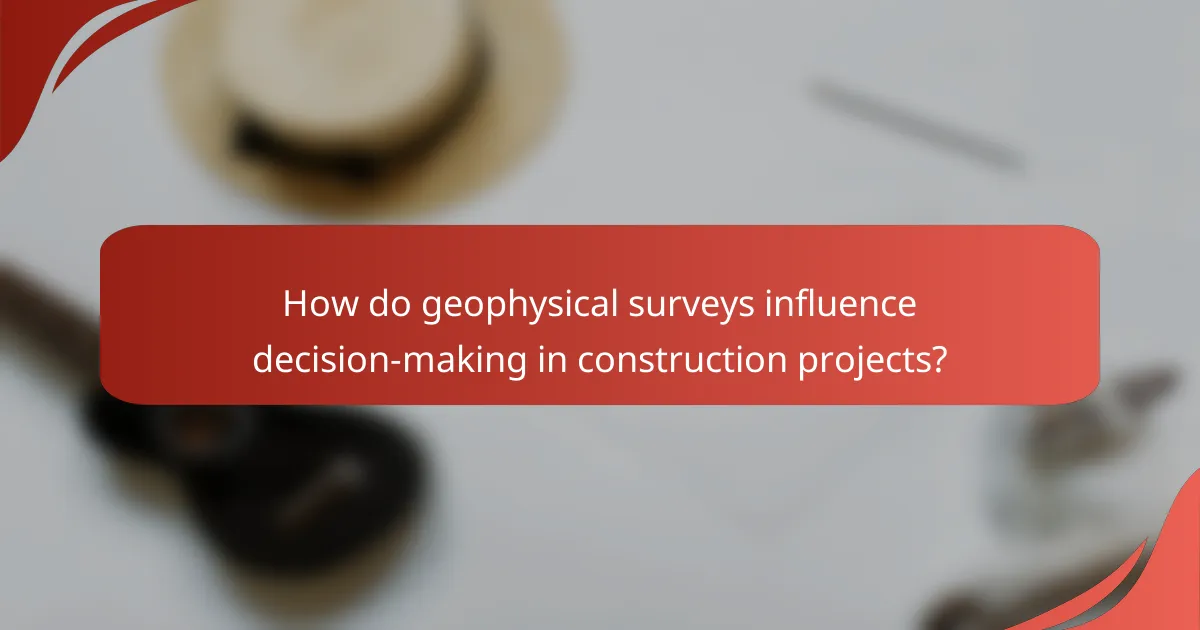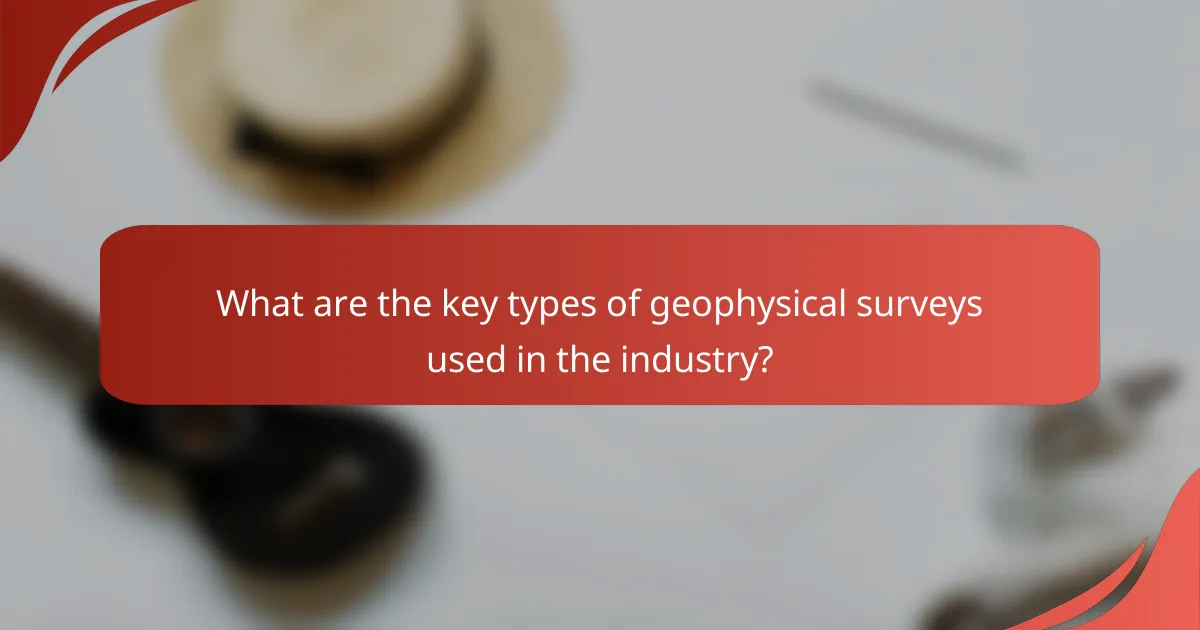Geophysical surveys play a vital role in decision-making for construction projects by delivering essential subsurface data that guides site selection, risk assessment, and cost estimation. By identifying geological conditions and potential hazards, these surveys enhance project planning and resource management, ultimately leading to more successful outcomes.

How do geophysical surveys influence decision-making in construction projects?
Geophysical surveys significantly influence decision-making in construction projects by providing critical subsurface information that informs site selection, risk assessment, and cost estimation. These surveys help identify geological conditions, potential hazards, and resource availability, leading to more informed and effective project planning.
Improved site selection
Geophysical surveys enhance site selection by revealing subsurface conditions that may not be visible on the surface. Techniques such as seismic reflection and ground-penetrating radar can identify bedrock depth, soil composition, and groundwater levels, allowing project managers to choose sites that minimize construction challenges.
For instance, a construction project in Bulgaria might utilize resistivity surveys to detect areas with high moisture content, which could impact foundation stability. By selecting a site with favorable geological conditions, projects can avoid costly delays and modifications later in the construction process.
Risk mitigation
Conducting geophysical surveys helps mitigate risks associated with construction projects by identifying potential hazards early on. Surveys can detect fault lines, sinkholes, or contaminated soil, allowing teams to develop strategies to address these issues before construction begins.
For example, a project in the United States may uncover an underground gas pocket through electromagnetic surveys. Recognizing this risk allows engineers to implement safety measures, such as adjusting the design or reinforcing structures, thus preventing accidents and ensuring compliance with safety regulations.
Cost estimation accuracy
Geophysical surveys contribute to more accurate cost estimations by providing detailed information about subsurface conditions that affect construction expenses. Understanding the geological landscape helps in predicting excavation needs, material requirements, and potential delays.
In Europe, for example, a project may estimate excavation costs based on survey data indicating hard rock presence. Accurate data can lead to more precise budgeting, reducing the chances of unexpected costs arising during the construction phase, which can often exceed initial estimates by significant margins.

What are the key types of geophysical surveys used in the industry?
The key types of geophysical surveys commonly used in the industry include seismic surveys, ground penetrating radar, and magnetic surveys. Each method offers unique insights and is suited for specific applications, influencing decision-making in fields like construction, environmental assessment, and resource exploration.
Seismic surveys
Seismic surveys utilize sound waves to investigate subsurface structures. By generating seismic waves and analyzing their reflections, these surveys can provide detailed information about geological formations, which is crucial for oil and gas exploration, as well as for assessing earthquake risks.
When conducting seismic surveys, it’s important to consider factors like the type of terrain and the depth of the target formations. The cost can vary significantly, often ranging from a few thousand to several hundred thousand dollars, depending on the project’s scale and complexity.
Ground penetrating radar
Ground penetrating radar (GPR) employs electromagnetic waves to detect subsurface anomalies. This non-invasive method is particularly effective for mapping shallow geological features, locating utilities, and assessing archaeological sites.
GPR is advantageous due to its speed and ability to provide real-time data. However, its effectiveness can be limited by soil conditions, such as high clay content, which may absorb signals. Costs typically range from hundreds to thousands of dollars per survey, depending on the area covered and the resolution required.
Magnetic surveys
Magnetic surveys measure variations in the Earth’s magnetic field caused by subsurface materials. This technique is widely used in mineral exploration and environmental studies to identify buried structures or anomalies.
When planning a magnetic survey, consider the area’s geological background and the depth of the target. The costs can vary, but they generally fall within the range of several thousand to tens of thousands of dollars, influenced by the survey’s extent and technology used. Proper interpretation of the data is crucial to avoid misidentifying features, which can lead to costly mistakes in decision-making.

What factors affect the accuracy of geophysical surveys?
The accuracy of geophysical surveys is influenced by several key factors, including survey methodology, equipment quality, and operator expertise. Each of these elements plays a crucial role in determining the reliability of the data collected and the subsequent decisions made based on that information.
Survey methodology
The choice of survey methodology directly impacts the accuracy of geophysical surveys. Techniques such as seismic, magnetic, and electrical resistivity surveys each have unique strengths and weaknesses, making them suitable for different geological conditions. For instance, seismic surveys are often preferred for subsurface imaging, while magnetic surveys are effective for identifying mineral deposits.
When selecting a methodology, consider factors like the target depth, resolution requirements, and environmental conditions. A well-planned approach that aligns the methodology with project goals can significantly enhance data accuracy.
Equipment quality
The quality of equipment used in geophysical surveys is vital for obtaining precise measurements. High-quality instruments can reduce noise and improve signal clarity, leading to more reliable results. For example, modern geophones and magnetometers often provide better sensitivity and resolution compared to older models.
Regular maintenance and calibration of equipment are essential to ensure optimal performance. Investing in reliable technology can yield long-term benefits, as accurate data reduces the risk of costly errors in decision-making.
Operator expertise
The expertise of the survey operators greatly influences the accuracy of geophysical surveys. Skilled operators can effectively interpret data and identify potential anomalies, while inexperienced personnel may overlook critical information. Training and experience in specific methodologies enhance an operator’s ability to make informed decisions during the survey process.
To maximize accuracy, ensure that operators are well-versed in the latest techniques and technologies. Continuous education and hands-on experience can significantly improve the quality of survey outcomes.

How do geophysical surveys impact project costs?
Geophysical surveys significantly influence project costs by providing critical data that can prevent costly mistakes and optimize resource allocation. By identifying subsurface conditions early, these surveys help in making informed decisions that can lead to substantial savings over the project’s lifespan.
Initial investment vs. long-term savings
The initial investment in geophysical surveys can seem high, but the long-term savings often outweigh these costs. For instance, avoiding unexpected geological issues can save projects from delays and budget overruns that may reach tens of thousands of dollars.
By integrating geophysical surveys into the planning phase, companies can reduce risks associated with construction and exploration, leading to more predictable project timelines and expenditures. This proactive approach can ultimately enhance profitability.
Cost of equipment and technology
The cost of equipment and technology for geophysical surveys varies widely based on the methods used, such as seismic, magnetic, or electrical resistivity techniques. Basic equipment may start in the low tens of thousands of dollars, while advanced systems can exceed hundreds of thousands.
Investing in the latest technology can improve data quality and survey efficiency, but it’s essential to balance these costs against the expected returns. Companies should consider leasing options or partnerships to mitigate upfront expenses while still accessing cutting-edge tools.
Labor costs
Labor costs for conducting geophysical surveys can be significant, as skilled professionals are required to operate equipment and interpret data. Depending on the project’s complexity, labor expenses can account for a substantial portion of the overall survey budget.
To manage these costs effectively, project managers should ensure that teams are well-trained and that workflows are optimized. Hiring experienced personnel may incur higher initial costs but can lead to better data interpretation and fewer mistakes, ultimately saving money in the long run.

What criteria should be considered when selecting a geophysical survey provider?
When selecting a geophysical survey provider, consider their experience, the technology they use, and their methods. These factors significantly influence the accuracy of the survey results and overall project costs.
Experience and expertise
Experience in the field of geophysical surveys is crucial. Providers with a solid track record are more likely to understand the complexities of various geological conditions and can offer tailored solutions. Look for companies that have completed projects similar to yours in scope and environment.
Expertise also encompasses the qualifications of the personnel involved. Ensure that the team includes certified geophysicists and technicians who are familiar with the latest industry practices. This can enhance the reliability of the data collected during the survey.
Technology and methods used
The technology employed by a geophysical survey provider can greatly affect the quality of the results. Advanced equipment, such as ground-penetrating radar or electrical resistivity tomography, can provide more detailed insights compared to traditional methods. Evaluate the tools and techniques they plan to use for your specific project needs.
Additionally, inquire about the data processing methods utilized. Effective data interpretation is essential for accurate results, so providers should use up-to-date software and analytical techniques. Comparing the methodologies of different providers can help you identify the best fit for your project.
